
Heidelberg University Researchers Discover Plant's Drought-Survival Mechanism
October 15, 2025| |
Researchers at Heidelberg University's Centre for Organismal Studies (COS) have discovered a molecular mechanism that plants use to reduce water loss during extreme drought and intense sunlight significantly. The discovery centers on the cysteine synthase complex, a protein complex located in the plant's chloroplasts. This complex acts as a sophisticated internal sensor, receiving and forwarding stress signals that are critical for initiating the plant's defense response to dry conditions. This mechanism is crucial for sustaining the plant's life during periods of water scarcity.
When the cysteine synthase complex is activated by stress signals—which include a nutrient signal from the roots and a specific plant hormone induced by intense light—it stimulates the biosynthesis of the plant hormone abscisic acid (ABA). ABA is the primary molecule responsible for regulating water conservation. It works by triggering the closure of stomata, the microscopic pores on the surface of leaves that function like vents to control the exchange of air and water vapor. By closing these pores, the plant effectively conserves water and prevents dehydration.
This groundbreaking research has significant implications for future agricultural practices. Based on these findings, the team was able to create a modified Arabidopsis plant that maintained growth while more effectively withstanding soil dehydration. The researchers believe this discovery offers a new approach for developing climate-resilient crops, providing a path forward for improving global food security in the face of ongoing climate change.
For more details, read the news article in Heidelberg University's Newsroom.
| |
You might also like:
- Drought-resistance Spray Developed for Crops
- CRAG Researchers Discover Protein that Confers Drought Tolerance to Plants
- Plant Tissue Engineering Improves Drought and Salinity Tolerance in Arabidopsis
Biotech Updates is a weekly newsletter of ISAAA, a not-for-profit organization. It is distributed for free to over 22,000 subscribers worldwide to inform them about the key developments in biosciences, especially in biotechnology. Your support will help us in our mission to feed the world with knowledge. You can help by donating as little as $10.
-
See more articles:
-
Plant
- New Gene Editing Technique Boosts Precision and Efficiency
- Heidelberg University Researchers Discover Plant's Drought-Survival Mechanism
- Drought-Resilient Alfalfa Offers Lifeline to Kazakh Farmers
- Scientists Discover Pair of Genes that Strengthens Wheat’s Defense Against Powdery Mildew
- Philippine Educators Convene to Help Develop Biotech Learning Materials
- Australia Approves Commercial Planting of GM Cotton
- Study Examines Impact of U.S. GM Crop Imports on Indonesia’s Food Self-Sufficiency
- Media Practitioners and Biotech Experts Discuss Biotech Updates in the Philippines
-
Read the latest: - Biotech Updates (December 3, 2025)
- Gene Editing Supplement (November 26, 2025)
- Gene Drive Supplement (February 22, 2023)
-
Subscribe to BU: - Share
- Tweet

